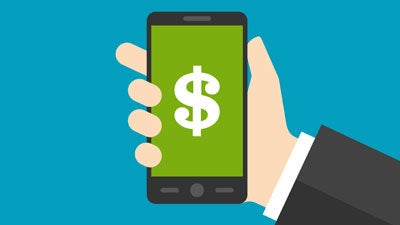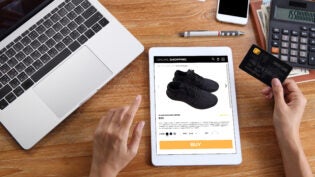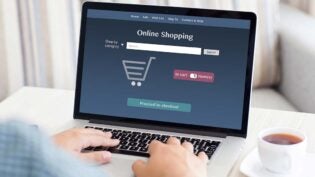Home > Technology > eCommerce >
Google Buy Button: Retailer’s Boon or Devil’s Bargain?
By: Chris Horton

Google meets Amazon; an interesting concept in theory which may become stark reality in practice soon enough. In a much anticipated move, Google is apparently preparing to incorporate buy buttons within some of its sponsored search ads on mobile devices. First reported by Alistair Barr and Rolfe Winkler in a recent Wall Street Journal article, many are reading the move as a proactive attempt to stop the steady bleed of users turning away from its heretofore desktop friendly search platform in favor of more mobile-focused ecommerce apps like Amazon and eBay. To be clear, nothing has happened yet, but mounting evidence suggests that will soon. If and when it does, the move to a Google buy button could be a boon for certain retailers struggling to grab the attention of itinerant and capricious mobile shoppers or, just as easily, a devil’s bargain for others trying to convert the same into long-term, loyal customers.
What It Is
So how exactly will the Google buy button work? According to the WSJ article, the buttons will accompany sponsored (paid) search results, which are often displayed under a Shop on Google heading at the top of the page. Buy buttons will not appear in organic search results. When mobile shoppers click on the buy buttons they’ll be taken to another Google product page to complete the purchase, where they can choose sizes, colors, shipping options, etc., as well as complete the purchase.
Related Article: 5 Best eCommerce Role Models
This last action—completing the purchase—is a significant one for retailers and therefore a potential source of controversy for Google’s buy button concept.
Under the current setup, retailers send data feeds to Google for the products they are selling online and then pay Google when shoppers click through to their websites. Under the new proposal, Google would take things one step further and handle the actual purchase transaction. In a stroke, its business model would shift from referral to transactional, from a purchase conduit to a purchase destination.
Not surprisingly, many retailers believe this would demote their relevance in the purchase cycle and weaken their relationships with shoppers.
And this is where things get tricky. In a cruel twist of fate for Google, many of its largest search advertisers happen also to be retailers. And, as the WSJ article aptly points out, Google can’t afford to upset retailers because they are among the largest spenders on the company’s search ads, according to a study last year by Ad Age and search marketing firm AdGooroo.
In fairness, Google is trying to ease retailers’ concerns by saying that it will allow shoppers who use the buy buttons to opt into the same marketing programs they would’ve been exposed to on retailers’ own websites. Moreover, Google promises that its product pages will be heavily branded for the retailers selling the items, and will include recommendations for other things to purchase from the retailer.
That all sounds great, but who holds the credit card data? Under the buy button program, Google will store shoppers’ credit card information and store the data for future purchases on its shopping pages. Furthermore, Google will not share this payment information with retailers, but will merely pass the payments on to retailers once they’ve been collected. In essence, Google is agreeing to pass along the fruits of the sale as long as it (Google) controls the means of its reproduction.
Hmmm…
On the bright side for retailers (I guess) Google is happy to be paid merely through its existing advertising model rather than taking a piece of the sales price of items, which is how eBay and Amazon do things.
With the buy button, Google is saying the same thing to retailers as it always has: you pay us to advertise products on our search engine, and we’ll get shoppers to buy them. This time around, though, the tech titan is altering the definition of how they’ll get shoppers to buy.
Why It’s Happening
OK, so we get the what; now how about the why? Ostensibly, like most other things in digital these days, it all has to do with mobile.
Data and common experience tell us that world is going mobile, a message that Google is hearing loud and clear. Commenting on the new AdWords overhaul, Google’s VP Jerry Dischler, who heads up product management for search ads, had this to say to John Koetsier of Venture Beat back in early May: “We’ve hit an inflection point….There are now more Google searches on mobile than on desktop in ten countries, including the U.S. and Japan.”
Indeed, the global surge in smartphone usage (according to Google as reported in the WSJ, searches on mobile devices now outnumber those on personal computers in 10 countries, including the U.S. and Japan) is compelling Google to fundamentally re-work its mobile ad delivery model.
For starters, mobile devices have smaller screens, and smaller screens offer less space for advertisements. Mobile ads also earn less money for Google, partly because of their lower conversion rates, which are in large part due to their smaller screens—or more precisely, the navigational hurdles and overall crappy user experience mobile shoppers face when clicking on a mobile ad and then having to enter in credit card and shipping information on their smartphone-sized screens. This is why many mobile shoppers now prefer mobile apps like Amazon and eBay, where personal information is preloaded and purchases are easier to navigate.
Google is positioning the buy button as a mobile commerce panacea of sorts that promises to resolve these nettling mobile UX issues. Google is telling its retail advertising partners that the new buy button will reduce friction and hasten the path to purchase for mobile shoppers, thereby improving mobile ad conversion rates. Better mobile ad conversion rates mean Google can charge more for mobile ads, and so it goes.
In a broader sense, one can see how having an instant buy button could benefit Google’s relevant stakeholders—its mobile users, its advertisers, and its shareholders—in three distinct (though interrelated) ways:
1. Keeps Mobile Users Happy – An improved mobile UX gives consumers a reason to shop through the Google search engine instead of ecommerce apps like Amazon and eBay.
2. Keeps Advertisers Happy – By making it easier for consumers to buy things through its search engine on mobile devices, Google can shore up its mobile advertising revenue model. Right now there are more mobile users than ever, and as noted above, it’s really inconvenient to complete a purchase transaction from a mobile ad on Google. By improving this mobile shopper experience Google can show advertisers higher conversion metrics and ultimately charge more for mobile ads.
3. Keeps Shareholders Happy – The buy button will allow Google to retain buyers’ financial information and collect more buyer data, which will improve ad retargeting and, eventually, ad revenue. Google’s new buy button and retail pages will allow the company to collect a plethora of data on consumer buying patterns, all of which can be used to refine its ad retargeting capabilities, once again enabling Google to charge more for mobile ads.
Moreover, Google’s retention of mobile shoppers’ credit card information, when combined with its heightened ability to retarget ads, could lead to even higher sales conversion rates through upselling and recurring purchases. All of this, once again, would allow Google to charge more for its mobile ads, further adding to the company’s already massive bottom line.
What It All Means
Putting things in a broader perspective, I view Google’s incorporation of a buy button as part III of a three-part act that started with its mobile-friendly search algorithm update (i.e. “Mobilegeddon”) back in April, and continued with the relaunch of its massively reworked but resoundingly mobile-centric AdWords platform in early May. Taken together, the two seem to pave the way for the buy button functionality on mobile ads.
On the balance, Google’s proposed buy button will probably be a good thing for mobile shoppers, just as it will likely be a great thing for Google and its shareholders. As to whether it will be boon or a devil’s bargain for retailers, the jury’s still out. I could easily see it benefiting retailers less interested in fostering consumer loyalty and instead looking to maximize one-time/impulse purchases, especially for products they are struggling to sell.
I suppose in the end it all comes down to friction. Reducing friction for mobile users, the buy button would also reduce friction for Google’s ongoing consumer data collection efforts, while at the same time adding friction (needing to get consumers to opt in, loss of control over consumer payments, etc.) for retailers trying to manage the purchase cycle and forge lasting connections with mobile consumers.
Retailers considering the Google buy button, then, would do well to remember that, as with so many things in life, the devil’s in the details.
This article was originally published by SyneCore
Published: June 17, 2015
3047 Views
3047 Views












